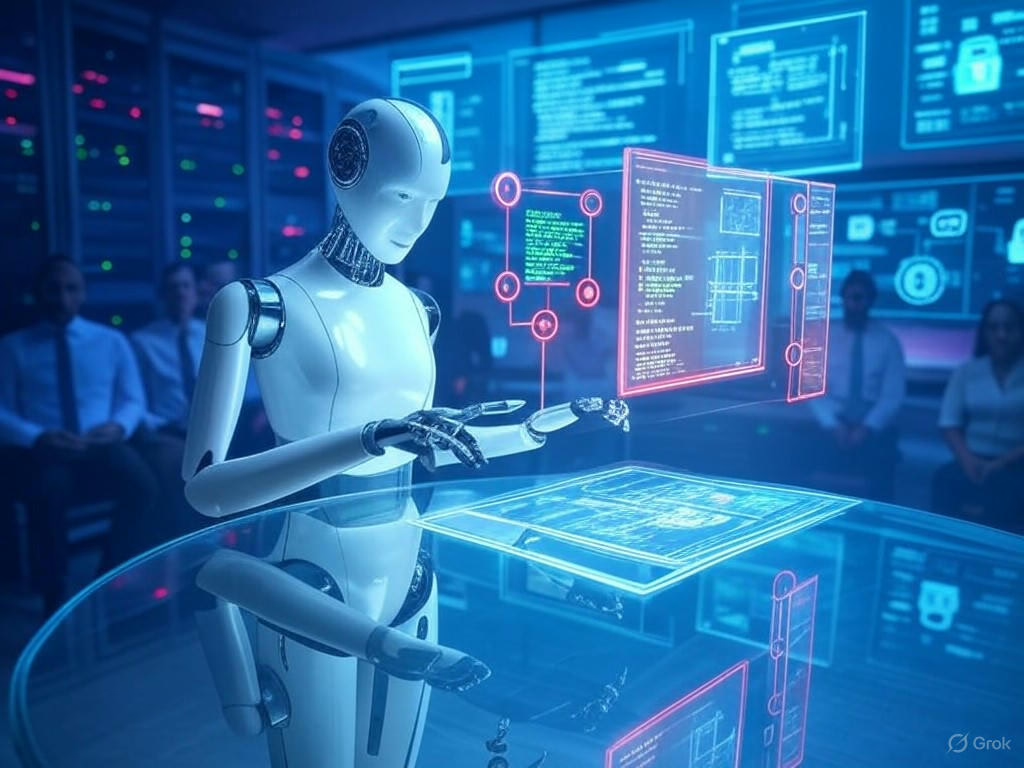So, here we are, standing at another crossroads in the digital age. It wasn’t that long ago we were figuring out firewalls and anti-virus software – relatively simple stuff, really. Then came the cloud, mobile, and suddenly security became this sprawling, complex beast. And just when you thought you had a handle on things, or at least understood the *rules* of engagement, along comes Artificial Intelligence, and it’s not just changing the game; it feels like it’s flipping the entire board over, pawns and all.
The chatter I’m hearing, loud and clear from the trenches of cybersecurity, is that AI isn’t just an academic concept or a fancy new tool for defenders anymore. It’s rapidly becoming the attacker’s best friend, arming them with capabilities that make yesterday’s phishing attempts look like crayon drawings compared to a Renaissance masterpiece. And the ticking clock on this feels rather urgent, doesn’t it? Some analyses highlight the year 2026, just around the corner, as a pivotal point where the escalating threat landscape, particularly from AI, necessitates a more structured, framework-based approach to cyber defence to avoid being significantly overwhelmed.
Attackers Get Smart(er) with AI
Let’s be blunt: the bad actors are leveraging AI, and they’re doing it with frightening efficiency. Think about it. Traditional cyber attacks often relied on scale or cunning, but there were usually tell-tale patterns. Phishing emails had clumsy grammar, malware variants required distinct signatures, and reconnaissance took time. AI changes all of that.
Now, attackers can use machine learning models to analyse vast amounts of data rapidly, identifying vulnerabilities and crafting bespoke attacks at speeds previously unimaginable. Spear-phishing, which used to be a manual, time-intensive operation targeting high-value individuals, can potentially be automated. An AI can sift through publicly available information, craft highly personalised and convincing lures, and launch thousands of these tailored attacks near-simultaneously. Imagine receiving an email that references a specific detail about your job, a recent purchase, or even a hobby – all gleaned and weaponised by an algorithm. It makes spotting a fake infinitely harder.
Then there’s the malware itself. AI can be used to create incredibly sophisticated, polymorphic malware that constantly changes its code and behaviour, making it exceedingly difficult for traditional signature-based defences to detect. It’s like trying to catch a shape-shifter. The speed at which new attack vectors can be identified and exploited is accelerating, putting defenders in a constant, exhausting state of reaction.
Playing Catch-Up
So, what happens when the attacker gains this kind of algorithmic advantage? Our current defences, often built on detecting known patterns, rigid rules, and manual analysis, start to look like a medieval castle facing drone strikes. They were designed for a different era, a different kind of fight.
Security Operation Centres (SOCs) are already drowning in alerts. Adding AI-powered attacks to the mix multiplies the noise and complexity exponentially. Human analysts, no matter how skilled, simply cannot process and respond to threats at the speed and scale that AI-driven attacks operate. It’s a fundamental mismatch in capabilities. We’re using binoculars while they’ve got satellite imagery.
The reactive nature of much of today’s cybersecurity is also a major weakness. We often wait for an attack to happen, analyse it, create a defence, and then push it out. By the time we’ve done that, an AI attacker has already mutated its approach or moved onto the next target. This isn’t sustainable. We need to shift from reacting to predicting and preventing, and frankly, that requires leveraging AI ourselves.
Building a Stronger Wall: The Framework Necessity
This brings us to the crucial point highlighted in the analysis: the urgent need for a robust, adaptive cybersecurity framework. Simply layering more security tools on top of an outdated foundation isn’t going to cut it. The 2025 marker, highlighted by some analyses, isn’t just a date; it’s a stark reminder of how quickly the threat landscape is evolving and the necessity of proactive change.
What does a framework approach actually mean in this context? It’s about moving beyond a piecemeal collection of tools and processes to a holistic, integrated strategy. It’s about defining clear policies, implementing best practices consistently across an organisation, and crucially, building in adaptability.
This isn’t just about technology; it’s about governance, risk management, and building a security culture. Frameworks like the NIST Cybersecurity Framework or ISO 27001 provide a structure, but they need to be implemented dynamically, allowing organisations to continuously assess their risk posture against evolving threats and adapt their defences accordingly. And yes, using AI *within* this framework for defence – think AI-powered threat detection, automated response, and predictive analysis – becomes not just helpful, but essential.
Think of it less like building a single, static wall and more like developing an intelligent, adaptive immune system for your digital infrastructure. One that can learn, recognise new pathogens (threats), and mount a targeted defence automatically, freeing up human experts for the truly complex investigations and strategic planning.
The Defenders’ Dilemma
Of course, this shift isn’t without its challenges, particularly for the people on the front lines. Cybersecurity professionals are facing immense pressure. Not only do they need to understand traditional threats, but they also need to grasp the capabilities of AI used by both attackers and defenders.
There’s a significant skills gap when it comes to understanding and operationalising AI in security. Training is vital, not just in using new AI security tools, but in understanding *how* AI works, its limitations, and how to collaborate effectively with AI systems. The future of cybersecurity defence likely involves a partnership between human analysts and sophisticated AI, where the AI handles the high-speed, high-volume tasks, and the humans provide the strategic oversight, complex problem-solving, and ethical judgment.
It raises interesting questions, doesn’t it? How do you build trust in AI systems that might make autonomous defence decisions? How do you ensure fairness and avoid bias in security algorithms? These are not just technical problems; they are human and ethical challenges that need to be addressed as part of the framework.
Looking Ahead: The Cybersecurity Arms Race
The race between attackers and defenders has always been a feature of cybersecurity, but AI is undoubtedly escalating it. The analysis underscores that waiting to see what happens is a losing strategy. The year 2025 serves as a useful, albeit somewhat representative marker highlighted by some analyses, highlighting the critical need for organisations to get serious about implementing comprehensive, adaptive security frameworks *now*.
This requires investment – not just in technology, but in people and processes. It requires collaboration, sharing threat intelligence, and developing industry-wide best practices for leveraging AI safely and effectively in defence. It also means government and regulatory bodies need to consider how to support this shift and potentially standardise requirements for critical infrastructure.
Are organisations prepared to make this leap? Do security teams have the resources and training they need? It feels like we’re entering a new, more complex phase of the cybersecurity struggle, one where intelligence, adaptability, and a strong, well-defined framework will be the keys to survival.
What steps is your organisation taking to prepare for this AI-accelerated threat landscape? Are you rethinking your security strategy around a comprehensive framework?



